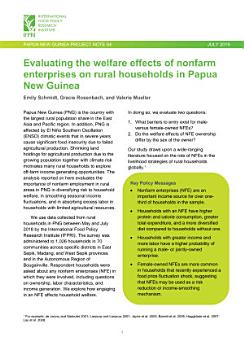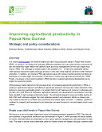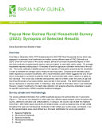Evaluating the welfare effects of nonfarm enterprises on rural households in Papua New Guinea
Schmidt, Emily · Rosenbach, Gracie
Jul 2019 · Papua New Guinea Project Note Book 4 · Intl Food Policy Res Inst
Ebook
8
Pages
family_home
Eligible
info
reportRatings and reviews aren’t verified Learn More
About this ebook
Papua New Guinea (PNG) is the country with the largest rural population share in the East Asia and Pacific region. In addition, PNG is affected by El Niño Southern Oscillation (ENSO) climatic events that in severe years cause significant food insecurity due to failed agricultural production. Shrinking land holdings for agricultural production due to the growing population together with climate risk motivates many rural households to explore off-farm income generating opportunities. The analysis reported on here evaluates the importance of nonfarm employment in rural areas in PNG in diversifying risk to household welfare (associated with weather shocks, crop pests and diseases, agricultural price fluctuations, etc.), in smoothing seasonal income fluctuations, and in absorbing excess labor in households with limited agricultural resources. Our study draws upon a wide-ranging literature focused on the role of nonfarm enterprises in the livelihood strategies of rural households globally, e.g., de Janvry and Sadoulet 2001; Lanjouw and Lanjouw 2001; Jayne et al. 2003; Barrett et al. 2005; Haggblade et al. 2007; Lay et al. 2008. We use data collected from rural households in PNG between May and July 2018 by the International Food Policy Research Institute (IFPRI). The survey was administered to 1,026 households in 70 communities across specific districts in East Sepik, Madang, and West Sepik provinces and in the Autonomous Region of Bougainville. Respondent households were asked detailed questions about any nonfarm enterprises (NFE) in which they were involved, including questions on ownership, labor characteristics, and income generation. We explore how engaging in an NFE affects household welfare. In doing so, we evaluate two questions: 1) What barriers to entry exist for male- versus female-owned NFEs? 2) Do the welfare effects of NFE ownership differ by the sex of the owner? Overall, we find that households with an NFE have significantly higher annual per capita consumption compared to matched households without an NFE, amounting to an average increase in the value of annual household consumption of 180 kina (PGK) per capita. In addition, households with an NFE consume approximately 9.5 grams more protein per person per day and achieve greater diversity in their diets compared to households without an NFE. We find that the positive effects of NFE ownership on welfare outcomes are largely driven by male-owned and jointly-owned (male and female) NFEs. The welfare outcomes attributable to female-owned NFEs are much smaller.
Rate this ebook
Tell us what you think.
Reading information
Smartphones and tablets
Install the Google Play Books app for Android and iPad/iPhone. It syncs automatically with your account and allows you to read online or offline wherever you are.
Laptops and computers
You can listen to audiobooks purchased on Google Play using your computer's web browser.
eReaders and other devices
To read on e-ink devices like Kobo eReaders, you'll need to download a file and transfer it to your device. Follow the detailed Help Center instructions to transfer the files to supported eReaders.







